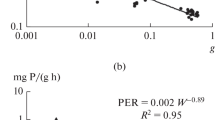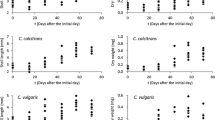Summary
Carbon turnover rates of young specimens of the freshwater snailAncylus fluviatilis are nearly equal for all organs, whereas in adult specimens intestinal organs (midgut gland and others) show considerably higher turnover rates than the ‘rest animal’ (animal without organs of the pallial complex).
Similar content being viewed by others
References
D. L. Buchanan, Arch. Biochem. Biophys.94, 500 (1961).
U. Speck andK. Urich, Z. vergl. Physiol.63, 405 (1969).
B. Streit, Arch. Hydrobiol., Suppl.48, 1 (1975).
B. Streit, Oecologia, Berl.,22 261 (1976).
G. A. Kerkut andM. S. Laverack, J. exp. Biol.34, 97 (1957).
K. Graszynski, Z. vergl. Physiol.59, 110 (1968).
K. Berg, Hydrobiologia4, 225 (1952).
Author information
Authors and Affiliations
Additional information
Supported by the Deutsche Forschungsgemeinschaft.
Rights and permissions
About this article
Cite this article
Streit, B. Studies on carbon turnover in the freshwater snailAncylus fluviatilis (Basommatophora). Experientia 32, 478–480 (1976). https://doi.org/10.1007/BF01920807
Issue Date:
DOI: https://doi.org/10.1007/BF01920807




